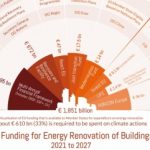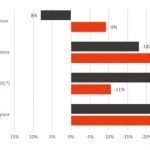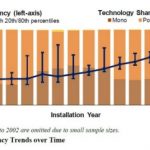The reduction in buildings emissions is well off track, not least in the residential sector. Something governments and millions of households are well aware of. The problem with replacing a gas boiler with a heat pump is the up-front cost and disruption. Installing the heat pump alone can cost several thousands more than replacing a gas boiler. On top of that, you should properly insulate your home and replace the radiators. Jovana Radulovic at … [Read more...]
Germany to ramp up the decarbonisation of Buildings Heating from Jan 1st 2024. How?
Decarbonising heating is a major challenge for any country. Germany’s Building Energy Act (GEG) means that from 2024 every newly installed heating system, in new or existing buildings, must operate with a minimum of 65% renewable energy. Concerns over the costs to customers (installing new and expensive systems, or paying a penalty for fossil heating) has led to intense debates, hence the new law includes a range of subsidies, bonuses, discounted … [Read more...]
Heating Households and Buildings: Heat Pumps will be up to three times cheaper than Green Hydrogen
A new study concludes that heating from 100% green-hydrogen would be up to three times more expensive than one based on 100% electrification of buildings with heat pumps. Josh Gabbatiss at Carbon Brief summarises the findings, who says it’s yet more evidence to push back against the voices of politicians and fossil-fuel companies wanting to see hydrogen in the household and buildings heating mix (for example, the UK is planning a “hydrogen … [Read more...]
U.S. Residential Distributed Solar: still getting cheaper, installation and permitting too, more batteries
John Rogers at UCS reviews the new and comprehensive “Tracking the Sun” report from Lawrence Berkeley National Laboratory which covers both residential and non-residential “grid-connected, distributed” solar PV systems in the U.S. There has been clear progress across the board, including PV module efficiency, system costs, installation and permitting, and the uptake of batteries. For example, median efficiency for modules in residential systems … [Read more...]
Aluminium, sulphur and salt batteries. Cheaper than lithium-ion, for homes and EV charging stations
The high and escalating demand for the lithium-ion batteries that dominate the market is driving the search for alternatives. Ideally, they will be made from inexpensive, abundant materials. David Chandler at MIT describes research there into a design that uses aluminium and sulphur as its two electrode materials, with a molten salt electrolyte in-between. The results point at batteries that have a projected cost per cell of about one-sixth that … [Read more...]
How a street can share a Ground Source Heat Pump
Ground and air source heat pumps are expected to play a major role in cutting the use of gas for heating. But one major problem with them is that they need a lot of space. For those living in dense housing it’s just not practical. District heat networks are the usual alternative, but the dense urban areas they serve need to be near a large source of waste heat like power stations or other industrial units. David Barns at the University of Leeds … [Read more...]
U.S. Solar breaks new records. What’s needed to keep the momentum?
The latest available data reveals it’s been a record breaking 2021 for U.S. solar. John Rogers at UCS runs through the highlights. Solar passed the 100GW milestone, with 23.6GW newly installed, up 19% on 2020 and 77% up on 2019. Solar was the biggest source of new electric generating capacity for the third year in a row. Residential, non-residential and utility-scale all performed well. Across the nation, solar accounted for 3.9% of total … [Read more...]
EU Buildings Renovations: get ready for minimum energy performance standards (MEPS)
To meet Europe’s 2030 climate targets the buildings sector must cut its emissions by 60%. That means annual renovations need to jump by an order of magnitude; at the moment it’s crawling at 1% per year. Worse, standard renovations save very little energy, just 9% in homes and 16% in commercial buildings. It’s the deep renovations that cut energy by 60% or more, but that’s only happening to under 0.3% of the stock. Louise Sunderland at RAP … [Read more...]
Buildings Renovation in Germany: success story or potential failure?
The German Federal Association of Housing and Real Estate Companies (GdW) has claimed that money and effort spent on the nation’s buildings renovations have not worked. But Andreas Rüdinger at IDDRI has looked into the evidence and concluded that the opposite is the case. CO2 emissions from the residential sector in 2018 were 37% lower than in 1990. Though final energy consumption was broadly stable, that’s because efficiency gains were offset by … [Read more...]
Distributed Solar: rooftop residential, commercial systems keep getting cheaper
In the U.S., PV module efficiency (median values) rose from 12.7% in 2002 to 18.4% in 2018, much of it in the last decade and a full percentage-point increase in the last year alone. The best modules are even more efficient, says John Rogers at the Union of Concerned Scientists. Improvements have come from manufacturing processes and cell architectures, and the increasing share of more-efficient mono-crystalline technologies: up from 40% in 2016 … [Read more...]











